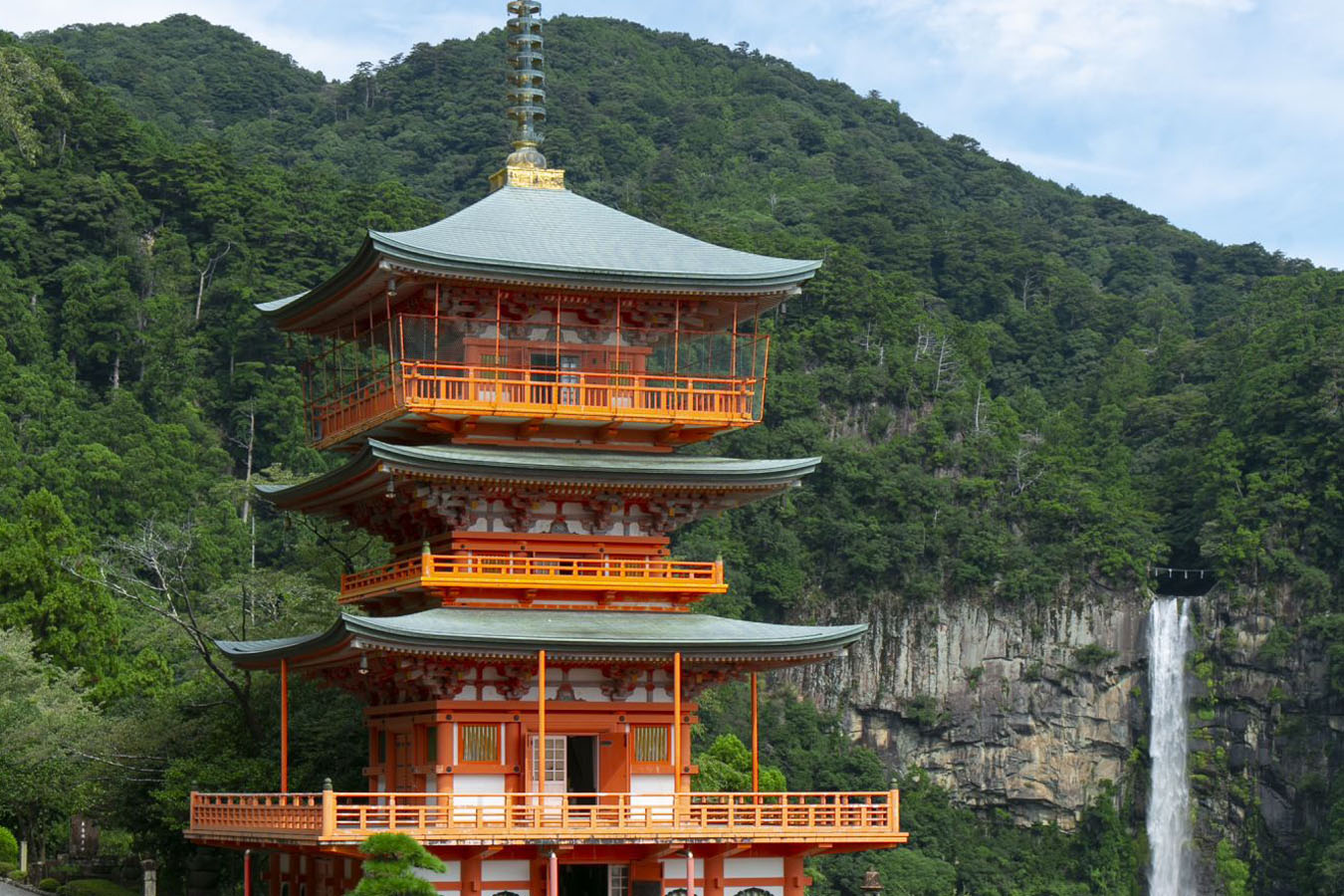
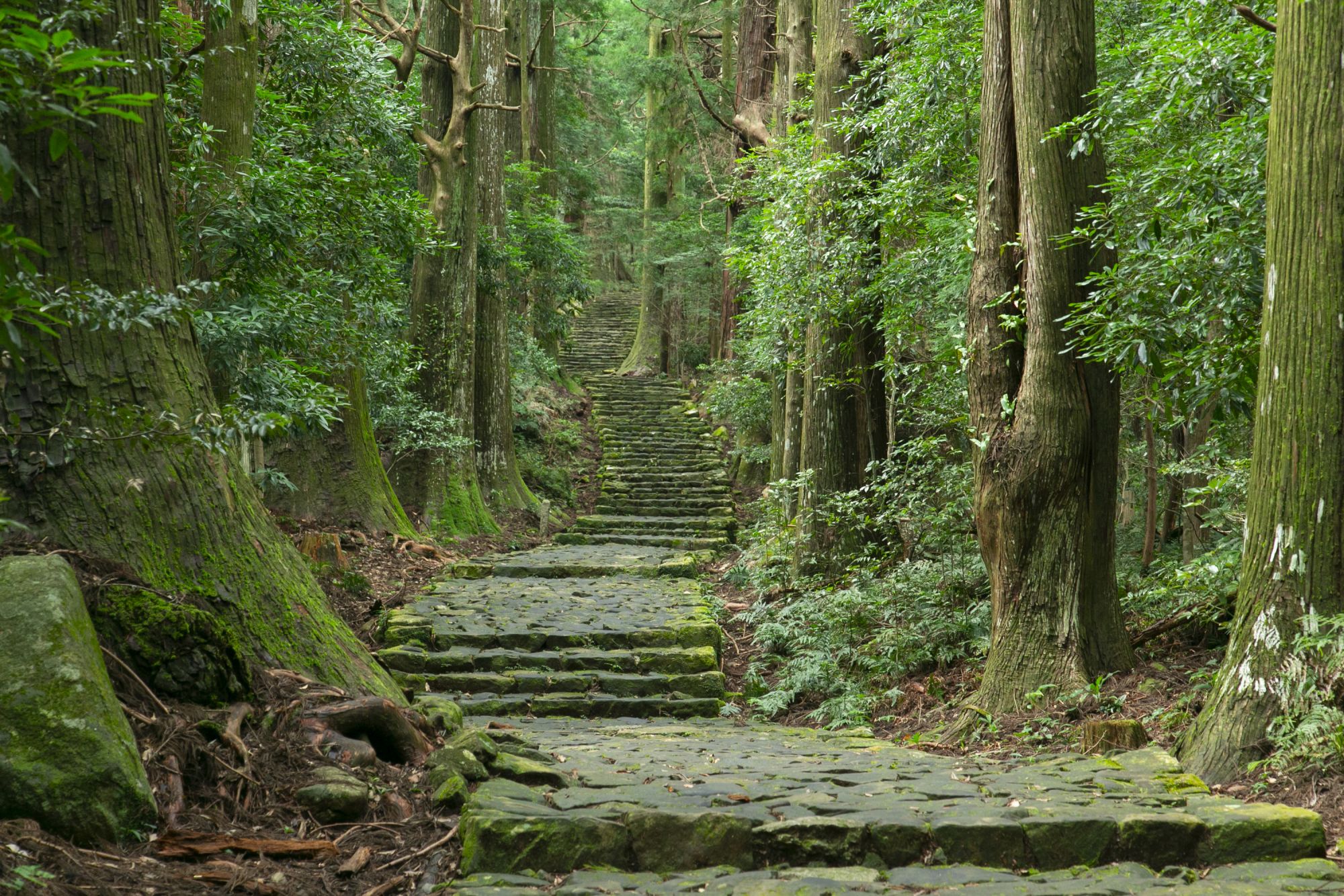

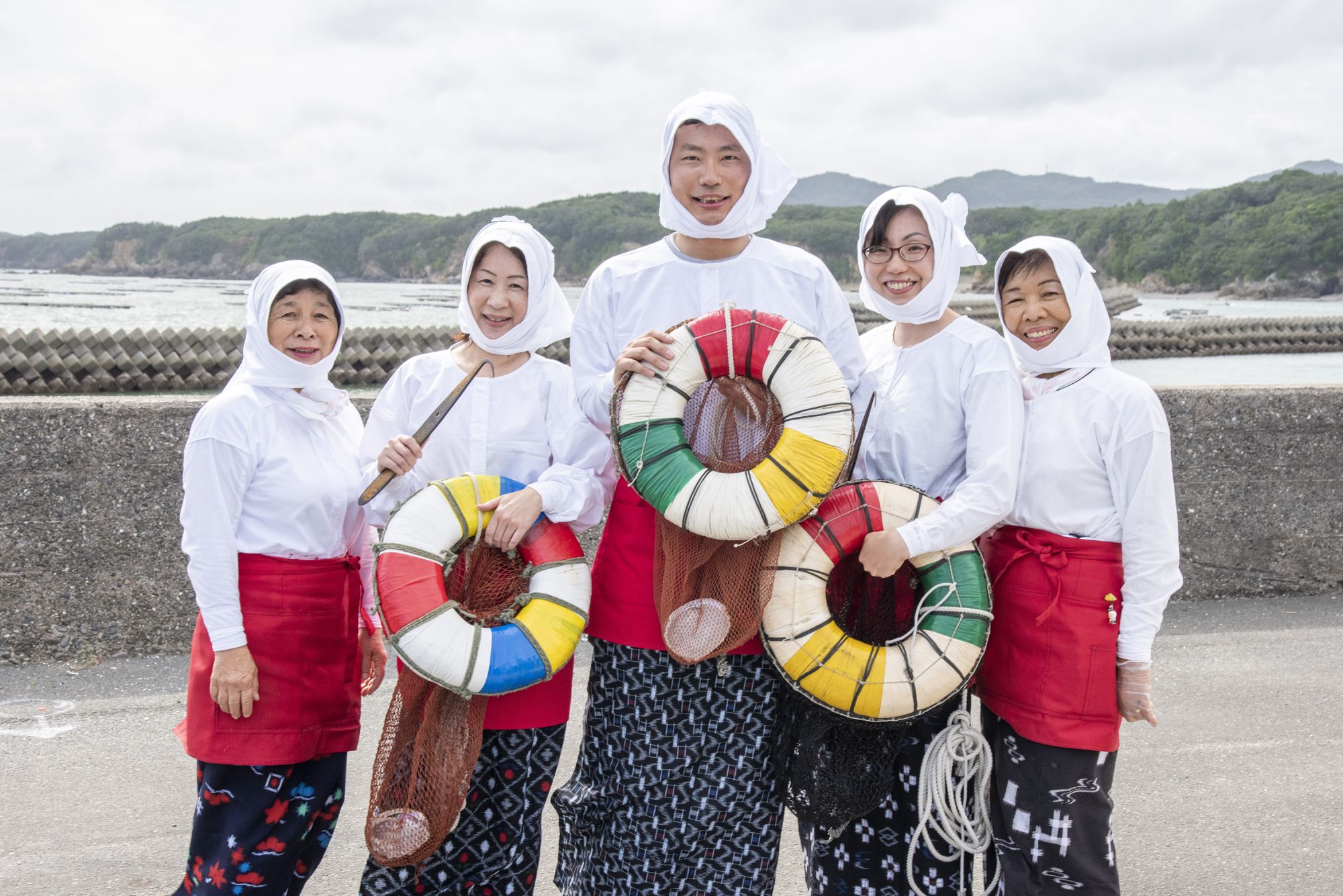
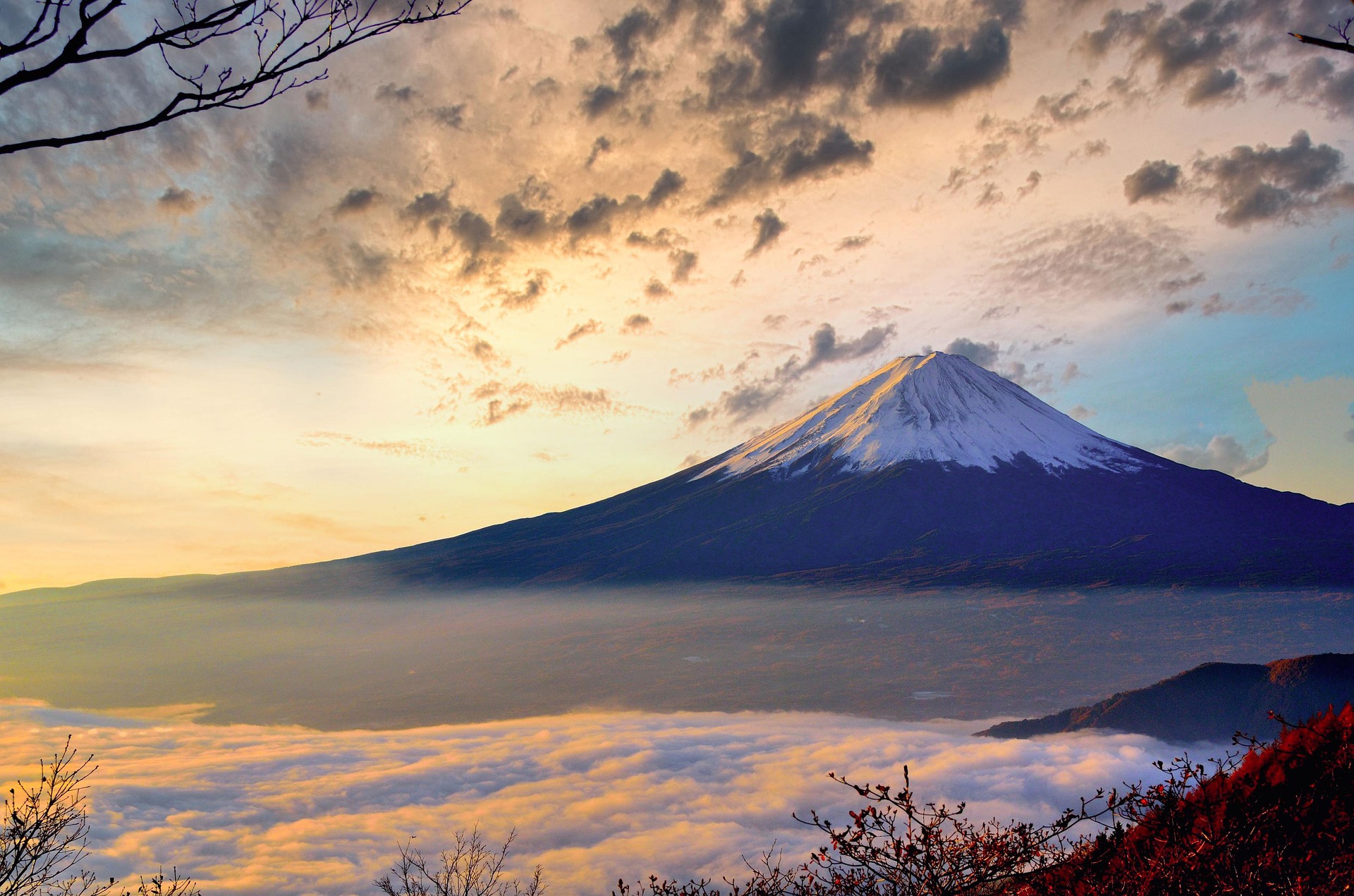
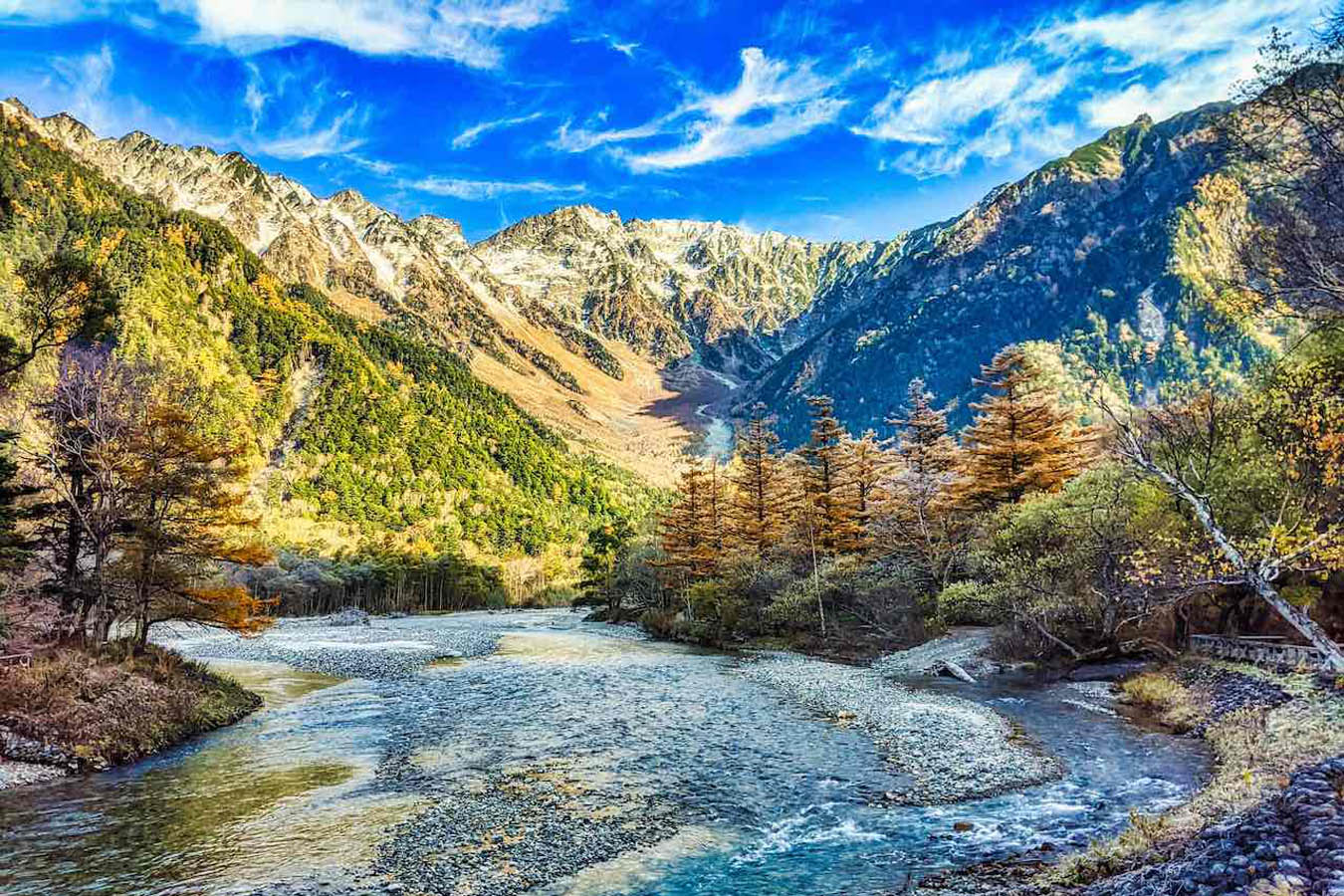
Highlights:
Detailed prices on request

The Kumano Kodo Pilgrimage Trail
©JNTO
After an overnight flight, arrival in Osaka. Here your German tour guide will welcome you and transfer you to the first group hotel on the Kii Peninsula. As a welcome, there will be a first dinner together.
Kumano Taisha
In the morning you will leave by public bus to the trailhead of today. You will drive into the depths of the pristine forests of the Kii Peninsula and hike for about three hours today along what is known as the Nakahechi Trail. Over the centuries, various routes have developed to the highest shrines of Kumano, with the Nakahechi Way being the one preferred by nobles and high dignitaries of the land. From Hosshinmon-oji, you will thus pass cypress trees, some of which are thousands of years old, to Hongu Taisha Shrine. In this more than 900-year-old shrine, in addition to 15 deities, the sacred three-legged crow Yatagarasu is also worshipped, which, according to Shinto myth, guided the first emperor of Japan, Jinmu, to Yamato. The shrine also includes the largest shrine gate Torii in the world. From here, you will hike on to the spring village of Yunomine-Onsen and check into a family-run hostel. You will enjoy a typical Japanese dinner and use the onsen (hot spring) of the house to relax extensively.
The Nachi Waterfall at Kumano Kodo
©JNTO
After a quiet morning in the clear forest air, make your way to the jetty. Just like the nobility in the Middle Ages, today you will go by boat down the river to Hayatama Shrine. During the trip you will enjoy the indescribably beautiful nature on the riverbank and hear stories about the gods who formed this landscape ages ago.
After paying your respects to the Hayatama and its deities, you will travel by train to Nachi, from where you will climb the hill of the Nachi Taisha Grand Shrine. Here you will also encounter one of Japan's most popular photo motifs: behind the shrine's pagoda, you can see the Nachi waterfall seemingly gushing out of the mountain!
Bridge to Ise Shrine
Today you will continue to the tranquil coastal town of Toba. Here you will meet some very special women: Ama. They follow a centuries-old tradition, diving mainly for pearls and abalone shells at depths of up to 20 meters without oxygen tanks. Over grilled fish and mussels, the Ama tell stories about their lives and everyday life.
Hereupon you will devote yourself to a very special shrine. The Ise Great Shrine is the holiest place in Japan. Its main temple is the only one that, according to ancient custom, is rebuilt every 20 years in a changed location, but with exactly the same architecture. The Japanese emperor, as the highest Shinto priest, is the only one who, along with a select few, is allowed to enter the highest sanctuary, which also houses the sacred mirror of the sun god Amaterasu, one of the regalia of the imperial family. The surrounding area and the small historic downtown in front of the shrine grounds make the visit a picturesque and unforgettable experience.
The Nagoya castle complex
In the afternoon, you will visit the Toyota Commemorative Museum and get an overview of the success story of this quite extraordinary family, which first built weaving machines and then established itself as a car brand that today is indispensable from the world market. From the first looms to robotic manufacturing, this is a fascinating experience.
Along the Nakasendo
Today is the first day you will hike along the ancient and picturesquely preserved Nakasendo trade route. Arriving at the historically preserved village of Magome, you will hike among medieval houses, rest houses, ancient temples and dense forests to Tsumago (about 3-4 hours). This village is also picturesquely located in a valley of the Kiso River and is reminiscent of the late Japanese Middle Ages. Did you know that at that time it was not allowed to travel by wagon? Wheeled vehicles were reserved for the imperial court alone. After a short train ride, you will spend the night in Kiso-Fukushima in a ryokan, a Japanese accommodation with its own Japanese dinner and onsen (hot spring).
The historical village Narai-juku
To get a taste of Japanese country life, you will extensively explore the village around our hostel. At the old Kiso-Fukushima border post, you will learn how difficult it must have been for people to travel in the Middle Ages. You were not even allowed to cross the principality border without a letter of permission. At the village's Kozanji Temple, you'll take in Japan's largest dry stone garden, picturesquely set against the green backdrop of the mountains. You will then visit the traditional residence of the Yamamura family, which today houses a small but fine museum. The afternoon is at your leisure. Visit the local foot bath and in the evening enjoy a feudal dinner at the hotel.
The black castle of Matsumoto
You will continue walking on the Nakasendo and through the Kiso Valley to the historic site of Narai-juku. Through your tour guide, you will learn numerous details of medieval life in Japan. In the afternoon, continue to Matsumoto (about 1 hour drive) and guided visit through the black castle. After a short train ride, you will reach Matsumoto, where you will visit the so-called black "Crow Castle" from the 17th century. You feel transported back to the time of the samurai princes. In addition, Matsumoto cultivates the art of traditional toy making. Therefore, you visit one of the traditional manufactories in the old town street.
The Kamikochi Valley in the Japanese Alps
By group bus today we go to one of the great highlights of the trip: To the Kamikochi high alpine valley. For several months of the year, the pass road cannot be used due to heavy snowfall. Once you are through the tunnel, you enter the spectacular valley at more than 1,400 meters above sea level, which is surrounded by dozens of mountain peaks. You will circle the Azusa River on a walk that will take several hours. The breathtaking beauty of the surrounding nature, coupled with wonderful views of the mountains, makes this approximately 3-hour hike an absolute highlight. In the afternoon, you will travel to the Winter Olympic city of Nagano. Here you will spend the night in one of the comfortable temple hostels of the city's great main temple, the Zenkoji Temple. Buddhist monks still eat a vegetarian diet. Therefore, you will also enjoy the so-called "Shojin ryori" today.
The sacred Fuji
After the morning prayer, which you can attend, visit the main temple with its "enlightenment labyrinth".
In the afternoon, you will continue by train to Fuji Hankone National Park, where you will spend the night today near Lake Kawaguchi, one of the five great lakes of Mount Fuji. The afternoon is free for you today. Relax in an onsen to prepare for the climb of Mount Fuji.
Fuji view from Chureito pagoda
Today is the day when you will start the exciting hike up not only the highest, but also the holiest mountain in Japan. At 3,776 meters, Mount Fuji is still an active volcano with an extinct main crater, which is considered one of the easy three-thousand-meter peaks among mountaineers due to its slightly rising cone shape. You will first take a bus to the base station, which is already at an altitude of just under 2,000 meters. The remaining 1,700 meters of altitude will be covered on foot. The first stage to the mountain hut, where you will rest until 2 a.m., you will cover the partly loose volcanic scree in about 4 hours. At the mountain hut there are only sleeping bags and group dormitories. Japanese curry and rice is typically served for dinner. It is worth taking some provisions with you.
"Nakamise-dori" in Asakusa
You rise in the middle of the night at 2 o'clock at the latest and follow by headlamp illuminated the secured paths to the crater rim of Mount Fuji, which you reach at sunrise around 4-5 o'clock. Banzai! You have conquered the highest mountain in Japan and greet Amaterasu, the sun goddess and mistress of Mount Fuji, with cheers and applause. After a breather, get ready to descend. After about 3-4 hours, you will return to the base camp and travel by bus to the last stop on your trip, the mega-metropolis of Tokyo. After arrival and check-in at the hotel, visit the surrounding Asakusa district. Here you will discover the faithfully reconstructed 17th century pilgrimage street "Nakamise-dori", which leads under huge paper lanterns all the way to the main Buddhist shrine of Sensoji Temple. The Skytree, the tallest building in East Asia and Tokyo's new television tower, can also be seen in the distance.
View of Tokyo
You will start the day with a short trip to the beautiful Ueno Park, which was once built as a large city park on the European model and today houses numerous national museums. Among them is a building by the French star architect Le Corbusier, whose buildings as a whole are UNESCO World Heritage Sites. Ueno Park is also one of the great picnic spots during the cherry blossom season. For lunch, you'll continue on to the flashy Akihabara district, which is all about manga, anime, computer games and maids (girls dressed as maids). After a few stops by train, you'll enter an almost enchanted forest of ancient trees, in the middle of which is the city's most important Shinto shrine: the Meiji Shrine. Completed in 1921, this shrine houses the divine souls of the Meiji Emperor and his consort. The Meiji Emperor is worshipped here as the god of scholarship, which is why students like to pray here for passing exams. In addition, people also like to get married here in a classical Japanese way. Directly in front of the garden is the crazy fashion district Harajuku with the screamingly colorful shopping street Takeshitadori. Have you always dreamed of a dress in the style of French dolls from the 19th century or always wanted to know how fancy some Japanese dress? Then this is the place for you. In the evening, you will conquer the Shibuya district with the busiest intersection in the world. In addition, you will learn the touching story of the most loyal dog in the world "Hachiko", whose story was once filmed in Hollywood with Richard Gere. A visit to the observation deck of the newly built Scramble Square skyscraper rounds off the evening, as from here you can view the world's busiest intersection from a height of 230 meters. A magical experience in the sea of lights of this gigametropolis!
Return journey
Today it is time to say goodbye. Your tour guide will accompany you to the airport and say goodbye to you. Sayonnara!




Kaiserdamm 105, 14057 Berlin
Takanoha Square 5th floor, 331 Kamiyanagicho, Shimogyo Ward, Kyoto, 600-8099 Japan
ジェイナビゲーター合同会社
〒600-8099 京都府京都市下京区上柳町331 タカノハスク エア5階